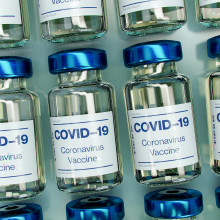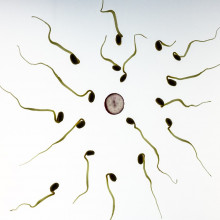The Future of Fertility
This week, the good news on vaccines for Covid-19, the helicopter taking to the sky on Mars, and the birds that make alarm sounds to scare females into mating with them. Plus, is the world facing a fertility crisis?
In this episode

00:50 - Impact of COVID vaccine programme
Impact of COVID vaccine programme
Aziz Sheikh, Edinburgh University; Mike Weekes, Cambridge University and Addenbrooke's Hospital
It’s been another big week on the covid front: the government outlined a roadmap to that will see us step back gradually from lockdown to a situation on 21st June when in Boris Johnson’s words “there will be no legal limitations on contact between us”. Nevertheless, some are concerned that the pace is too fast, and schools returning on 8th March is going too far too soon. But what’s certainly influencing the equation now are the vaccine statistics. Close to a third of the adult population have now received at least one dose, and confidence in the initiative received a further shot in the arm this week when data from a preliminary analysis led by Edinburgh University’s Aziz Sheikh showed a dramatic - potentially more than 90% - reduction in cases of Covid-19 hospitalisations among elderly people who’d had the jab…
Aziz - So we were interested in investigating the effects of the first dose of the Covid-19 vaccines. And in particular to study what impact there was on risk of ending up in hospital with Covid-19. So what we've created in Scotland is a cohort of virtually the entire population, 5.4 million people. What we've done is we've linked up their general practice data with the vaccination records, with hospitalisation records. And what we were able to do was track these individuals over time, the group that was vaccinated and the group that was unvaccinated. So we studied over 1.1 million first doses of the vaccine and the outcome of interest in this particular study, that was the risk of ending up in hospital, we were able to establish that for both groups.
Chris - And the results? What did you find?
Aziz - Individuals - whether they were given the Pfizer vaccine or the AstraZeneca vaccine - from day seven onwards, both vaccines were effective in reducing risk of hospitalisation. There is quite a substantial effect in preventing against hospitalisations.
Chris - And how big is substantial?
Aziz - The peak effect that we were seeing was an 85% reduction with the Pfizer-BioNTech vaccine at 28 days, and a peak effect of 94% with the Oxford-AstraZeneca vaccine at the same time point.
Chris - And when you say peak effect, have you got sort of a confidence range here where you think it's at least this and probably not more than this? So what is that range?
Aziz - Let's do the Pfizer-BioNTech one first of all. Confidence intervals around that were 76-91%. And then with the AstraZeneca, they were 73-99%, that's for the corresponding time periods.
Chris - One other country pursuing this quite heavily - Israel - do your results broadly agree with what they're finding?
Aziz - Yes, they do. I mean Israel is slightly ahead of us in that respect and they're implementing the Pfizer-BioNTech vaccine. They're also showing substantial reduction in hospitalisation, but they've also over the weekend reported on reductions in the risk of transmission.
Chris - Now, this kind of protection really matters because if we can not only protect people from developing severe illness, but also stop them actually catching the new coronavirus full stop, this is going to have a very significant effect on our ability to control the spread of the infection, particularly among people who may have no symptoms. And this is really important in settings like hospitals, where an infected staff member could pass the infection to a vulnerable patient. But as Cambridge-based infectious diseases consultant Mike Weekes explains, the jab does cut the number of cases by a very significant margin.
Mike - We specifically examined staff at Addenbrooke's hospital who report well to work without any symptoms of coronavirus. And because we test about four and a half thousand staff a week, we can determine the proportion of people who have asymptomatic infection, infection without any symptoms. And what's happened is that since January, the occupational health department has been organising a mass vaccination campaign. So that by now more than 90% of Addenbrooke's staff are vaccinated with the Pfizer vaccine against Covid-19. And so by combining our testing programme and our vaccination programme, we can answer the question, "If you're vaccinated, are you just prevented from being sick with Covid-19 or are you prevented from being infected with Covid-19?" And that's a really important question because if the vaccine prevents infection, it prevents transmission to others and it prevents transmission to vulnerable patients.
Chris - What's the control group here? 'Cause obviously you've got to compare things with something else in order to know whether or not the vaccine is making a difference. So how are you doing this?
Mike - So what we did was we compared on a week by week basis, people who had and hadn't been vaccinated as the vaccination programme was being rolled out. So our control group was people who weren't vaccinated and the test group was people who were vaccinated.
Chris - First of all then Mike, how many people in total were detected as asymptomatically infected across the period that you studied?
Mike - We specifically looked at a two week period because that's when the number of people in the unvaccinated group was about constant. And so we found about 40 or 50 or so in total who were infected.
Chris - And how does that contrast with people who had been vaccinated? In other words, what is the impact of vaccination on catching and therefore potentially transmitting coronavirus infection?
Mike - There was a four times reduction in the number of people who became infected in the vaccination group compared to the unvaccinated group.
Chris - This must be music to your ears then.
Mike - It's really, really good news actually. Fewer people being infected, particularly fewer people being infected without symptoms, means that they won't go into work completely unaware that they have Covid. It means they won't transmit to their colleagues and they won't transmit to vulnerable patients. And that's four times fewer transmissions.

07:18 - Redistributing surplus COVID 19 vaccine doses
Redistributing surplus COVID 19 vaccine doses
Robin Cohen, Oxford University
The UK Covid vaccine programme is well under way. But as we’ve heard a few times on this show, the SARS-COV2 virus presents a danger until the whole world has been vaccinated. This week, Ghana received its first 600,000 doses of the Oxford/AstraZeneca vaccine. Following India, it is the second country to receive covid vaccines distributed by the scheme COVAX - an organisation working to ensure fair distribution of covid vaccines around the world. Robin Cohen is professor of development studies at the University of Oxford. Katie started by asking Robin about COVAX...
Robin - Well, it was set up primarily by the World Health Organisation. France was also very involved in its initial foundation. And the idea was initially to create a big purchasing block that would be able to negotiate with the big pharmas [pharmaceutical companies] in the case of the companies that are trying to make money out of the vaccines, and with AstraZeneca, who I think as everybody knows is doing it more or less on a freebie basis, or an at cost basis. And the idea was that COVAX would create buying power that would allow a lot of poorer countries and middle income countries access to these vaccines at scale.
Katie - How's it going?
Robin - Well, it's not too bad. Of course, there are two aspects of it. One is that you need the funding to buy the vaccines in the first place. And a number of countries have come to the party in that respect. It's basically [the] World Health Organisation that is brokering COVAX and creating the institutional framework under which it works. So quite a few countries have come, including the UK, to add their money to the COVAX pot. So they bought quite a few vaccines. Not of course, as many as they need. At the moment, they've got roughly about 20 to 30% of the vaccines that they would need to vaccinate a big proportion of the world.
Katie - You've written about richer countries ordering more vaccine doses than are actually needed to immunise their populations. Why is this happening? And what scale are we talking about?
Robin - Well, the scale is really quite enormous. Now let me start by saying, although there are lots of people who've made indignant moral comments about this and said, "why on earth do people need this? Is this a form of vaccine gluttony?". My own view is that basically there was no way in which the procurement agencies could really determine which of the vaccines were safe and effective and gain regulatory approval. So this is not as it were a moral argument at first, but now it is becoming so because it's becoming clearer and clearer that there are many more vaccinations available to rich countries than they could ever possibly use. So just to give you an idea of the magnitude of what we're talking about, if we take collectively Canada, Australia, New Zealand, the EU, the UK, and the US, and put them all together in one bundle, it's well in excess of 1 billion surplus vaccinations, I mean, full vaccinations. So as it were two where two are necessary. So that's an awful lot of vaccinations that are going begging in the medium term. And what we now need to do is ensure that this redistribution is possible, probably through the agency of COVAX.
Katie - Is there another factor to bear in mind here, which is if countries need more than previously thought, for instance, if say someone makes an immune response to the viral vector in a vaccine and therefore dose two can't necessarily be the same type as dose one. Is that something that's important to consider?
Robin - That definitely is important to consider. There are all kinds of issues. There are also production delays, this has been experienced by AstraZeneca in Europe, as we know in mainland Europe. So there are all kinds of contingencies here. But if you take pretty well everything in the round, how many are spoiled, how many might be needed to cover additional variants and so on, there is undoubtedly a very large number remaining that need to be redistributed. And we need to create the mechanisms whereby this happens equitably and fairly.
Katie - What are the logistics of redistributing these vaccines to places that need them?
Robin - Well at the moment, the basic idea is that the countries that are definitely not going to use what they've ordered would be able to divert through donation or through sale. And I suppose there are all kinds of other political issues then come in - do you try to use vaccines to influence your foreign policy outcomes? And we've noticed this happening, particularly in the case of China and Russia, but also in some other cases. So we might, for example, look at the current discussions between the US and Mexico, where the Mexican president is suggesting that the US should send surplus doses to Mexico precisely at the time where they are complex trade negotiations between Canada, the US and Mexico occurring. So there's a very, very complex political structure around the issue of redistribution.
Katie - Would all of the vaccines be suitable for this? Do you think?
Robin - Well, of course it's been argued that not every vaccine can be redistributed because certain of them need a good cold chain. But with a little bit of imagination, it is possible certainly to use all vaccines in most countries. For example, one can create cold, cool ports in airports, international airports in places like Johannesburg or Cape town or Rio de Janeiro, Sao Paolo and redistribute even cool chain, cold chain vaccines at that point.

14:17 - Perseverance: a helicopter on Mars
Perseverance: a helicopter on Mars
To our near planetary neighbour, Mars! And Adam Murphy looked at the newest addition to the Martian landscape: the Perseverance rover, and its travelling companion, the helicopter Ingenuity…
Adam - On the 18th of February, the population of Mars increased by one robot.
The NASA rover Perseverance touched down in the Jezero Crater after a nail biting 7 minutes where it had to land itself safely. Perseverance is just beginning its mission, trundling around in what’s thought to be an ancient lake bed looking for indications of life, and there are some amazing photos to go with it. And, for the first time, some sounds.
[sfx]
That is the martian wind. The breeze on another planet, millions of miles away. And it’s going to pose an interesting challenge to Perseverance’s friend. Usually we send the rovers up alone. But this time, it’s got a buddy, a little helicopter called Ingenuity. Ingenuity is a solar powered drone that hitched a ride on the belly of Perseverance. Drones are becoming common annoyances here on Earth, but making something fly on another planet is a real challenge. The martian atmosphere is very, very thin. The atmospheric pressure on the surface of mars is less than 1% of what it is here on Earth. And it’s much colder than here. The average surface temperature is -63 degrees c.
Both of those pose a big challenge for a helicopter. To take off, a helicopter needs to generate lift. When a wing (or a rotor) whips through the air, it pushes against it. And since as Newton said, every action has an equal and opposite reaction, the air pushes back. If you’ve shaped and angled that wing just right, the push back is upward. But if there’s less air, there’s a lot less to push back against. Like trying to swim in air, instead of water. Which I don’t recommend. It looks very silly. So the rover is super light, its rotors are quite long, and they spin much, much faster than a traditional helicopter, nearly five times faster, to get as much lift as possible.
This is all a proof of concept for a Mars helicopter. It’s to show that it can be done. Nothing is certain in space exploration, but the plan is for it to take a few 90 second flights above the Martian surface over the course of the next month or so, and take some incredible photographs. A view of Mars we’ve never seen. If it can, it opens a lot of avenues for exploration. A rover can’t go everywhere, but a little helicopter buddy could scout ahead, could visit nearby locations the rover couldn’t. Even help the humans who make it to Mars. Which is a lot of pressure on the shoulders of such a little robot. Although not air pressure of course.

17:59 - Lyrebirds trick mates into staying in bed
Lyrebirds trick mates into staying in bed
Anastasia Dalziell, Wollongong University
Superb lyrebird are large songbirds only found in forests in Australia. They’re famous for their incredible ability to mimic sounds - from forest creatures to drills - and they also put on elaborate song and dance displays for potential female mates. Now, scientists have uncovered another sexual song the male lyrebird will sing, which is the one you just heard. It is, they think, an imitation of what’s called a ‘mixed species mobbing flock’ - essentially the alarm calls small birds will make if they see a predator. And it looks like the male birds make these sounds to deter females from running off when they’re trying to mate with them. Eva Higginbotham heard from the University of Wollongong’s Anastasia Dalziell how she made the discovery...
Anastasia - I was recording a very nice male, and the male had just paused in his dawn singing. He'd just taken a break. He was eating some worms. He was quiet and sort of scratching, digging for more food along the ground. And suddenly I saw him stand up straight, and throw his tail over his head, and a female walked into the scene. It was a very exciting moment. And then the odd thing was, he then ran off away from the female, but straight to one of his many display mounds. So these are the circular patches on the forest floor, and she followed him and then I had to follow them. It was really difficult because the forest floor was littered with fallen-over gigantic trees, and hidden things to stumble over. And it was well above my knee in bracken, and it was quite a difficult run. It was really a very intense moment for everyone involved, but I got there and I got to the mound where he was performing his song and dance, to play to the female. She was on the mound with him. It was amazing to see. And then just at the moment that he got on top of her, he switched to this mobbing flock mimicry. It was really clear to see it happen. It was very abrupt. And then of course he was on top of her for about, it was 45 seconds or so, and throughout he was mimicking the mixed species mobbing flock.
Eva - Essentially the male birds, while they're mating, they start doing this amazing mimicry, trying to sound like lots of other upset, small birds that have noticed a predator nearby?
Anastasia - Exactly. So of all the wonderful sounds that the male superb lyrebird can imitate, and does at other times, it's this moment, which you can think, perhaps it's the peak of sexual selection. He's mimicking the buzzy alarm calls. It's absolutely extraordinary.
Eva - Why do you think they're doing this?
Anastasia - This is extremely difficult to interpret, but it wasn't until a bit later when we started to put cameras on male display mounds, so these sort of camera traps, to really film the males during their displays and during their sexual interactions with females, that we started to get a handle on what we think is going on, and noticed that there was another context in which males were switching to the mobbing flock mimicry. And this happens when a female approaches the male on his display mound. And as we'd seen in the other examples, he puts on a big song and dance display to her with his tail over his head and the full lyrebird specific songs. But often these dances don't end in a mating. They end, rather, when the female steps off the mound and seems to go away. And it was the moment the female stepped off, that a male would stop singing his song and dance display, and switch to this mobbing flock mimicry. So now we had two sexual contexts in which the male was producing the mobbing flock mimicry, during copulation itself, and when the female was attempting to leave the male without mating. It was a very strong relationship between female behaviour attempting to leave, and male production of mobbing flock mimicry. So we thought about this and we concluded the best explanation that explains his use of it in both contexts, is that he's attempting to prevent the female from ending the sexual interaction before he's managed to transfer sperm to her, saying something like baby, it's dangerous outside, stay here, safe with me.
Eva - How similar is this mimic of the mobbing flock sound to the real mobbing flock sound? And is it similar enough that the lyrebird females definitely think that this is a real mobbing flock?
Anastasia - We tested the similarity in two different ways. And the first way we did it is we compared the acoustic properties, measured acoustic properties of male mobbing flock mimicry, and then recordings that we've made of actual other species in a mixed species, mobbing flock. And we compare the acoustic parameters and we concluded that they were indeed remarkably similar. And then the second way we tested is by conducting an experiment to test whether birds perceive the similarity between the mimic and the model like we do. So I did a playback experiment by placing a speaker in a forest, and broadcasting the sound of lyrebird mimicry of the mobbing flock, or recordings of real mixed species mobbing flocks. And then we scored how these other members of the forest, other birds responded to those. And we found that as far as their behaviour was concerned, they behaved in the same way, regardless of whether it was a mimicry, or the real mixed species mobbing flock. So it's quite convincing evidence that birds with their very different hearing from ours, also perceive the similarity between the lyrebird mimicry and a real mobbing flock.

24:05 - Why Australia couldn't access news on Facebook
Why Australia couldn't access news on Facebook
Peter Cowley, Angel Investor
For a while now, the Australian government and tech giants Facebook and Google have been at loggerheads regarding a law which would make organisations like these pay the news outlets which produce the content that the tech giants currently run for free on their sites. This recently led to Facebook removing its services from Australia, which have now been reinstated. Katie Haylor got the view of Angel investor and tech entrepreneur Peter Cowley...
Peter - Facebook took down its newsfeeds. So it didn't allow news to be displayed on Facebook pages for consumers in Australia. Unfortunately they also took down some other things they shouldn't have done, but it was only temporary because it's now been restored, because they have now signed a deal with the content providers, i.e. the big entertainment companies such as Nine and Murdoch's empire, et cetera, to pay that. So money then is flowing from the consumer, via the distributor, Facebook or Google, back to the media content providers, the publishing companies, the big print houses, et cetera.
Katie - What's the backdrop of this dispute?
Peter - The backdrop is because of a disagreement that's rumbled on for about a decade between the content providers and the content distributors, i.e. between the Murdochs and Nine Entertainments of this world, and the people who display things on our screens, on our phones, and our laptops, et cetera, and a disagreement about the amount of money each should be having from the amount that we effectively pay as consumers. In fact, it's got over to Europe as well recently. And Microsoft is now working with parts of the European Commission to make sure this doesn't happen over here in Europe.
Katie - What's the response of the Australian authorities?
Peter - I don't know Katie. I would think the Australian authorities are saying: "Good. They're sorting themselves out without us having to interfere." Because any law change, as we all know, has unintended consequences. So if it can be done in a way that suits both parties, so effectively the providers and the distributors, then the laws, although they probably will be put into place in case something goes wrong in the future, are certainly less urgent.

27:08 - How scientists forecast future populations
How scientists forecast future populations
Brienna Perelli-Harris, Southampton University
Quantifying population growth now and forecasting into the future is an important task - for instance, to know how big a nation’s future workforce will be, how many school places you need etc. So how do scientists actually accomplish this? Brienna Perelli-Harris is an expert on human populations from Southampton University, and spoke to Katie Haylor...
Brienna - Well, demographers tend to use three different types of forecasting methods. The UN uses Bayesian estimation techniques, which takes into account many different previous estimation trends, and when they calculate their forecast they tend to have a lot of uncertainty. So they might have a median-variant, but they do include lots of uncertainty based on what has happened previously. The IHME, which produced a study that was very publicised - it was in the Lancet - over the summer... they tend to make assumptions about contraceptive use and education, but it was rather controversial because many of the assumptions, especially in Africa, didn't really line up with what other demographers were seeing had happened in Africa, because of the stall in fertility in certain regions of Africa.
And then the other way that demographers tend to forecast populations is by estimating how education is going to change over time, because women's education has been one of the most important factors for declining fertility. And this technique also takes into account expert opinion. So these different approaches have been used to forecast global population in general.
Katie - I guess it's important to distinguish between biological fertility, and reproductive choices and agency, isn't it? How does biological fertility stack up as a potential impactor on population change?
Brienna - In general we've seen that the most important factor is age. So as you know, women's reproductive age tends to end around 45-49, and although this has been pushed forward a little bit with assisted reproductive technologies and IVF, it really hasn't pushed that boundary very far; and we see very few births occurring after the age of 45. That is what we take into account most in terms of the biological capacity. And in fact, there have been studies... for example, I did some research in Ukraine, which as you remember was impacted by Chernobyl, and there was a lot of pollution in the environment. And in the early 2000s, I found that only 5% of the population remained childless. This is really due to social norms that have really pushed couples to have children really early, and if you start early, or if a population starts early - around the age of 20 - then childlessness can be very rare, or relatively rare. Although we take into account fecundability on the population level, it's not the main consideration that we demographers use to think what populations are going to do in the future.
Katie - Okay. So what you're saying, is the main biological factor is maternal age. What is the overall biggest factor? Because I would have assumed it's probably finances. Is that true?
Brienna - Yes, and preferences, and... but you're right that economic uncertainty has been one of the most important reasons why certain countries on average have had lower fertility rates. Also, family policies are really important: to what extent couples can balance work, and family, and childcare, and maternity leave. That has also been really important. Also - we talk about gender equality, and to what extent men actually contribute to household labour, as being also really important for these decisions about how many children to have.

32:10 - Female fertility: air pollution and ovaries
Female fertility: air pollution and ovaries
Catherine Aiken, Cambridge University
Now they say it takes two to tango, and fertility has both male and female factors. Cambridge University obstetrician and researcher Catherine Aiken spoke to Chris Smith about the female side of fertility...
Chris - Catherine, I suppose that the pandemic must have had an impact in and of itself on fertility rates, because of people choosing to defer whether or not they have a child, because of concern around what might happen?
Catherine - Yes, absolutely. So at the start of the COVID pandemic, everyone was talking about a baby boom. It now looks much more like COVID's going to produce a baby bust. Having said that, at Addenbrooke's and Cambridge we certainly haven't seen an empty labour ward; in fact, we seem to be busier than ever. But we are hearing reports from hospitals that are just emerging that there are now fewer pregnancy dating scans being done, so fewer people booking for pregnancies; and there are also several large surveys that suggest people are delaying pregnancies, as you say, due to financial concerns: particularly rising unemployment, but also they cite direct health fears about COVID. And interestingly, the lack of their usual social networks and support seem to be really concerning people. And all of them seem to be contributing to fewer rather than more pregnancies this year.
Chris - Do people in reality have anything to worry about? As in, if they do fall pregnant while they are experiencing this... the pandemic situation, and were they to catch coronavirus infection while pregnant, what do the data say about the likely outcomes?
Catherine - What we know is that when women are pregnant, they are slightly more susceptible to the severe outcomes of COVID than when they aren't. And that's true for many viral illnesses, such as flu for example. We are very good at treating that, we're very good at picking it up early, and the healthcare system is very aware of it at the moment, but certainly COVID infection during pregnancy has been linked with preterm birth, reduced growth of the baby inside the womb, and more severe outcomes for mum overall. We know that COVID doesn't seem to transmit readily across placentas, but the effect on the mum can certainly have knock on effects on babies. But I would emphasise that being pregnant at the minute really is, in general, not a dangerous thing, and that we're good at dealing with that when it does occur.
Chris - And are there any documented impacts on fertility, having caught COVID? Because we've heard in recent weeks about the possible impact on male fertility, and perhaps we'll hear a bit more about that when we talk to our next guest in a moment, but is there any evidence that catching coronavirus can affect an ability of a woman to reproduce?
Catherine - We really don't have any good evidence that COVID directly impacts female fertility. Now, clearly there may be indirect impacts: for example, increased anxiety and stress can certainly reduce the chances of conception. There's also factors like increased weight gain and less healthy lifestyles during lockdown that may well be impacting on fertility. And certainly there was reduced access to fertility treatment, particularly in the early stages of the pandemic when many IVF clinics and so on closed their doors. And there are theoretical concerns: the binding receptors for COVID, which it needs to get into cells, are expressed in the female reproductive tract. But there really isn't any strong evidence that this is actually clinically significant in reducing female fertility.
Chris - Well, there's some reassurance there then. Based on what you did say though, that there are other factors that we do know are linked, do you think that they account for the decline in fertility that we've seen: the numbers I cited at the beginning of the programme, an apparently quite dramatic reduction in the rate of reproduction in women in America between just 2006 and 2020. Things like weight gain, things like diet, exercise, smoking - can we account for this reduction in fertility in those terms?
Catherine - I think we can account for a large part of it, yeah, I really do. I think as Brianna said, maternal age is the absolute key driver more than anything else. And we know that since 2013, the average age of women giving birth in the UK has been well above 30, which means a reduction in egg quality or a reduction in egg number, and that does just have an impact on population fertility. But obesity's also a big influence on reproductive health, and one in five women who books a pregnancy in the UK at the moment is obese at the start of pregnancy. One in eight women is a current smoker during pregnancy in the UK at the moment. And then in global terms, there are many more interesting factors; some linked with climate change, some linked with endocrine disruptors, ,and the impact of air pollution.
Chris - Well, we'll return to this question of endocrine disruptors, things coming from the environment that can mimic the body's own hormones... we're going to talk to Paul Fowler later in the program about that, he's actually been looking specifically at that. But air pollution is a big one as well, isn't it? This is something which we know is getting worse and worse and worse, and is very strongly linked to rate of mortality; but could it also be impacting on fertility then?
Catherine - Well, there certainly are plausible observational studies that link ambient air pollution to both longer times to spontaneous conception and to less successful fertility treatment. There are some good rodent studies that show that there are plausible mechanisms that link that. Because eggs stay in this arrested development stage for so long, the DNA is uniquely sensitive to external influences, and we know that air pollution particles can reach the ovaries. Air pollution might also affect transport of eggs and sperm, but I think what I'd emphasise is that the majority of human studies in this space are very observational, we don't have any good quality prospective studies, and we really need to know more about how in practice, the health of women, the reproductive health of women who live in high pollution areas is impacted.

Male fertility: sperm and stress
Bill Colledge, Cambridge University
We've heard about female fertility, let's turn now to male fertility. Katie Haylor spoke with Bill Colledge, a reproductive physiologist from Cambridge University. Firstly, Katie asked Bill if there's any evidence that the Covid-19 pandemic could be impacting male fertility...
Bill - Well, it's an interesting question. There was a study that was published just a few weeks ago where they were looking at indicators of male fertility, such as sperm numbers and the motility of the sperm, after individuals had a COVID infection. And they found that there was an impairment in the sperm quality even three months after these individuals had got over the initial COVID infection. So that would indicate that if you have a COVID infection it can alter the quality of the sperm. But I would like to reiterate here that you probably would see the same thing with other viral infections as well, such as influenza. There is data to suggest that sperm quality goes down after an influenza, and it's probably more related to the body fighting off a virus in general rather than just COVID. So that's often associated with a high fever and we know that a high fever can impair sperm quality.
Katie - So I guess knowing how long that lasts must be quite a crucial question, right?
Bill - It's a very crucial question. The study only looked after three months, they didn't go any further out than that. So we don't really know how long it would take for the sperm quality to get back to normal. They also didn't relate it to fertility, they were simply looking at sperm numbers and motility. And of course, fertility is a different aspect - is it possible for those individuals to still conceive, even though they have impaired sperm?
Katie - What about stress and anxiety? Catherine mentioned it as some sort of indirect influence. Is there evidence to suggest that stress and anxiety can impact male sperm?
Bill - There is evidence that high stress can alter the male reproductive axes. So if you're under a lot of stress and you have this stress hormone cortisol being produced in the body, that will tend to suppress the reproductive axes, which could lower the amount of testosterone in the body which you need in order to make sperm. So under those conditions you could actually see a reduction in the number of sperm being made - perhaps not so much a change in the quality of the sperm, but just in the quantity.
Katie - Catherine was mentioning the sorts of factors that are understood to influence female fertility outside of the context of the pandemic. Broadly, does that list look the same when we're talking about male fertility?
Bill - It's pretty similar actually. Obesity is a very important contributory factor in male fertility, mainly because individuals that are obese tend to have lower testosterone levels. And as I've said, you need testosterone to get your body to make the sperm, so everyone that has an increase in 9 kilograms has a 10% reduction in fertility. So there's a direct correlation there between body weight and obesity and fertility. There are other factors that also affect male fertility - smoking, I think was mentioned as affecting females, but it will also affect male fertility. There are substances within cigarette smoke that are not very good for sperm production - there are toxic substances like cadmium and lead, and they will certainly interfere with sperm production. And then of course the various toxins that you might find within the environment. Sperm formation is very, very sensitive to these substances, and if you get them in your body it can compromise the sperm formation.
Katie - And what about air pollution? Have there been studies done looking at air pollution and sperm?
Bill - There have been studies done, but as Catherine said, the problem with most of these studies is they tend to just be correlations and they often tend to be done in small groups. The best way to look at this is to look at all of the studies together and to do what is called a meta-analysis to try and put all of the publications into one, and to do the statistics on that to look at whether air pollution can affect male fertility. There has been a meta-analysis done in 2015, and they did show that air pollution does correlate with reduced sperm motility, but it didn't seem to affect overall fertility levels. So again, you've got to be careful talking about a reduction in sperm numbers and how that might affect fertility.
Katie - Now we've heard a number of reports in recent years about sperm quality and quantity being on the decline. Is this the case? What evidence is there to support this? Is it seen across the globe or is this a UK problem?
Bill - So there are several studies over the last 20 years that have clearly indicated a decline in the number of sperm. And again, if you look at all those studies together and you do a meta-analysis, there was a very good meta-analysis done in 1992, and what they found was that indeed there is a reduction in the number of sperm being produced and the amount. So I think in 1940, the average sperm count was 113 million per ml, but by 1990 it had dropped to 66 million per mil. So there has been a significant reduction in the number of sperm. Now this tends to only affect the Western developed countries. Studies have been done in Asia, and they have been done in China. There is some evidence to suggest similar reduction in sperm numbers, but less pronounced. So it does seem to be mainly in the developing Western countries.
Katie - And in just the last sentence, do we actually know why this is happening?
Bill - It's multifactorial, but probably obesity and weight gain will be a big component in this.

Endocrine disruptors and fertility
Paul Fowler, University of Aberdeen
So far we’ve looked at male and female factors that can influence fertility, and we’ve touched on how the environment might be involved. One way it might play a role is if we encounter chemicals that can mimic some of the hormones used in our bodies to control reproductive processes. These are called “endocrine disruptors” and Chris Smith spoke with Paul Fowler from the University of Aberdeen who researches them...
Paul - Well they fall into a lot of categories. So things like organic pesticides, products of combustion so dioxins, polycyclic aromatic hydrocarbons, phthalates - which are softeners, things like parabens, which is used in a lot of body care products. Bisphenols, including the controversial Bisphenol A. Cigarette smoke contains a lot of endocrine disruptors as Bill mentioned. Non-stick coatings PFOA and PFOS, which are very, very persistent in the environment. Food contact materials, so again, Bisphenol A as a tin liner, for instance. So a wide range of compounds.
Chris - How can a compound that lines a tin can, or something in a cigarette, end up behaving the same way in the body as a hormone?
Paul - Hormones typically act on one or a few receptors. A lot of these receptors have evolved over time from structures that detected the environment, and they now detect these chemical signals sent around the body. And it is possible, if the shape of the molecule, or the binding part of the molecule to the receptor, for a non hormone to act on the hormone system. But it can also do that by other means - if it interferes with the production of the hormone or the breakdown of the hormone or the secretion of the hormone, it can seriously inbalance the endocrine system. Hormones frequently act in concert, so you have a cascade of hormones and an endocrine disruptor may affect a different element from the one you end up looking at.
Chris - So they're basically chemicals with the capacity to throw a spanner in our hormonal works and disrupt very delicately orchestrated signalling pathways in the body, which could have a knock-on effect for things like fertility. Is there actually evidence though that this is happening?
Paul - Well, there's a lot of animal data and quite a lot of that data is of good quality, not all of it. And that supports the effects of some of these compounds, for instance Bisphenol A and phthalates, for endocrine disrupting effects that lead to impaired fertility.
Chris - This is exposing animals to these chemicals does actually translate into a change in their fertility?
Paul - Yes, it depends on which chemical and what dose.
Chris - Sure - but does that happen naturally? As in, have we got evidence that rather than doing this in a laboratory situation where we effectively expose animals to high levels of these things, are they picking up enough of the stuff in the environment, in the same way as we're kind of speculating humans might, for this effect to be manifest?
Paul - Yes, we are. So in terms of wildlife, so non experimental animals, there's been cases of male fish in UK waters and elsewhere producing female egg proteins. And this is due to, amongst others, products from contraceptive pills getting into the water system. There've been plenty of observations of impaired masculinisation in wildlife. A lot of that data has come from areas that are relatively polluted, like Lake Apopka in Florida.
Chris - Okay there's reasonable evidence for that, but it's a different thing to say that humans are susceptible in the same way. So is there evidence that it's impacting us?
Paul - Well, there's associative evidence - and I think all three of your speakers before me alluded to that - that there are studies that associate people with say a higher level of a particular compound with an increased risk of something. If you take the woman, an increased risk of endometriosis with certain compounds, or reduced birth weight of offspring, and that's been linked to a PFOS, for instance, so women with higher levels of PFOS. And in terms of lab evidence that's difficult.
Chris - I was going to follow up Paul by saying, do we know whether this is a comprehensive effect across all aspects of reproduction in both men and women, or whether it's hitting chiefly one aspect of reproduction? Do we know?
Paul - We don't.
Chris - Could there be a legacy effect here? In the sense that, say a child is exposed as it's developing inside its mum to something, could that have an impact, even though the baby hasn't been exposed directly, could that have an effect on the fertility of her unborn child?
Paul - Yes, that's potential. And an example would be some small studies conducted a while back that looked at the chance of a woman having a baby was lower if her mother's mother had smoked while pregnant.
Chris - Goodness. So we're storing up potentially quite a problem for ourselves. And could it be then that what we see now as a decline in fertility could be an even bigger issue in the next generation?
Paul - Well, that's possible. One thing to bear in mind is that the profile of chemicals we're exposed to is continuously changing. If you take sewage sludge, for instance, processed human sewage used as a fertiliser on fields, the processing of sewage changes over time as new ways and better ways are found to make it safer. At the same time manufacturers are changing what's coming into the food chain. So all the pressure to ban Bisphenol A has led to some manufacturers switching to Bisphenol S and Bisphenol F about which we know much less.

51:06 - QotW: 3D vision and broken sunglasses
QotW: 3D vision and broken sunglasses
Eva Higginbotham's been casting her eye about for the answer to listener Pavel's question...
Eva - A curious question indeed, but it turns out that everyone with normal vision should be able to experience this. I dug out my dusty sunglasses and put the question to 3D vision expert Andrew Glennerster from the University of Reading.
Andrew - Pavel asks about a very interesting phenomenon that was discovered and published almost exactly 100 years ago by Carl Pulfrich. He was one of the world's leading experts on stereoscopic, otherwise known as 3D, displays at the time. Ironically, he was blind in one eye so he could not see the effect himself.
Eva - In the cinema, 3D movies work by sending a different image to each eye by a combination of a clever filming technique and the 3D glasses you wear. But this phenomenon is a little different, and you can try it out yourself at home without any fancy kit, as Andrew explains.
Andrew - If you put a dark filter over one eye (eg using one lens of a pair of glasses, as Pavel describes) this slows down the processing of the image in that eye. So, when the brain compares the images in the two eyes, it is using a delayed version from the dimmed eye. That means that if an object is moving from left to right and the left image is dimmed, the rays of light that the brain receives are the same as if the object really was further away.
Eva - If the object moves in the other direction, the depth effect is reversed, and the faster the motion the greater the effect.
Andrew - For example, this means that a pendulum that’s really swinging in front of you in a flat plane will appear to move along an oval-shaped path in depth, that is, it’s coming nearer to you as it swings to the left, and further away from you as it swings to the right. But it will reverse direction and move the opposite way around the path if you swap the filter and put it over the other eye.
Eva - And it works on more interesting objects than just a pendulum - it was used in a Diet Coke ad in 1989, and Doctor Who used it extensively in their 1993 charity special Dimensions in Time.
Andrew - So, Pavel is describing an effect that has generated a lot of scientific interest; it even has clinical implications for recent ophthalmic therapies. But, as you can see, wearing a dark lens is no substitute for the 3-D glasses you use in the cinema: you wouldn't want to watch a film in which people walking left to right were close and people walking the other direction were far away!
Eva - Thanks Andrew! And if you want to give it a go for yourself, you can grab your sunglasses, head to youtube and look up ‘Pulfrich effect’ spelled the German way with an R I C H at the end, where there are lots of videos designed just for that. Next week, we’re considering this question from Michael
Michael - Why can’t batteries such as AA and AAA size be recharged? What’s the difference between regular batteries and rechargeable especially lithium versions? Is this a “Big Battery” conspiracy to sell more batteries, or are their valid reasons?










Comments
Add a comment